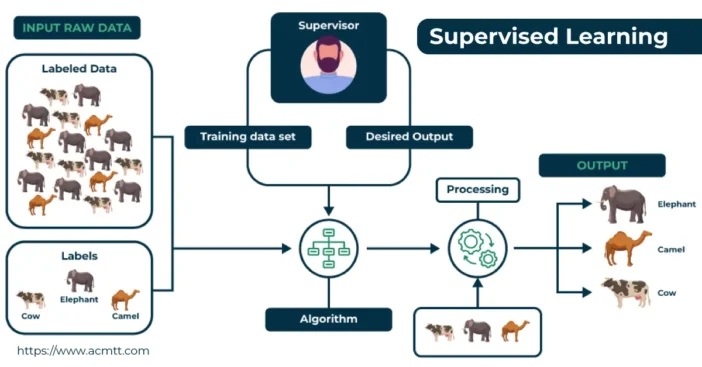
Introduction
Supervised learning stands as one of the most crucial techniques in the field of machine learning, laying the foundation for countless real-world applications. From recognizing handwritten digits to predicting stock prices, supervised learning is responsible for training algorithms that can generalize and make accurate predictions based on labeled data.
In this article, we’ll explore what supervised learning is, the key differences between supervised and unsupervised learning, its types, popular algorithms, and data-driven applications across different industries. We’ll also address commonly searched questions to clarify its role in AI development.
What is Supervised Learning?
Supervised learning is a machine learning technique where an algorithm is trained using labeled datasets. In this approach, each training data point consists of an input feature set and a corresponding output label. The algorithm’s job is to learn a mapping function that generalizes to unseen data, making accurate predictions when presented with new inputs.
This learning approach involves two key phases:
- Training Phase: The algorithm learns patterns by minimizing the difference between its predicted output and the actual output using a loss function.
- Testing Phase: The model is evaluated using unseen data to test its ability to generalize.
By the end of training, the model should have adjusted its internal parameters, such as weights, to achieve optimal prediction accuracy.
Supervised vs. Unsupervised Learning
One of the most common questions asked about supervised learning is how it compares to unsupervised learning. Let’s break down the key differences:
| Aspect | Supervised Learning | Unsupervised Learning |
|---|---|---|
| Definition | Trained on labeled data (input-output pairs) | Trained on unlabeled data (no explicit output labels) |
| Goal | Learn to map inputs to known outputs | Find hidden patterns or groupings in data |
| Main Techniques | Classification, Regression | Clustering, Dimensionality Reduction |
| Example Applications | Spam detection, house price prediction | Customer segmentation, anomaly detection |
Supervised learning is often preferred when historical data with labels is available, making it suitable for problems like predicting disease outcomes or recognizing speech.
Types of Supervised Learning
Supervised learning tasks generally fall into two main categories:
1. Classification
- In classification tasks, the goal is to predict discrete output labels or categories.
- Example: Email spam detection, where emails are classified as either “spam” or “not spam.”
- Common Algorithms:
- Decision Trees
- Support Vector Machines (SVM)
- K-Nearest Neighbors (KNN)
2. Regression
- In regression tasks, the goal is to predict continuous output values.
- Example: Predicting house prices based on features like size and location.
- Common Algorithms:
- Linear Regression
- Ridge and Lasso Regression
- Neural Networks
Popular Algorithms in Supervised Learning
- Linear Regression:
- Used for predicting continuous values by fitting a linear equation to the data.
- Logistic Regression:
- A classification algorithm that predicts the probability of a categorical outcome.
- Decision Trees:
- A tree-like model that splits the dataset based on feature values to make predictions.
- Support Vector Machines (SVM):
- Effective in high-dimensional spaces, used for both classification and regression tasks.
- Neural Networks:
- Multi-layered structures that learn complex patterns and are widely used in deep learning.
How Does Supervised Learning Work?
Supervised learning typically follows these steps:
- Data Collection: Gather a labeled dataset where inputs are paired with known outputs.
- Data Preprocessing: Clean the data, handle missing values, and perform feature engineering.
- Training the Model: Feed the data into an algorithm, which learns by minimizing a loss function.
- Model Evaluation: Test the model on a separate dataset to measure its accuracy and generalization.
- Deployment: Use the trained model in real-world applications.
Common Questions About Supervised Learning
What is meant by supervised learning?
Supervised learning is a machine learning method where an algorithm learns from labeled examples, making it possible to predict outputs based on new input data.
What is supervised vs. unsupervised learning?
The key difference is that supervised learning uses labeled data to predict outputs, while unsupervised learning works with unlabeled data to find patterns or clusters.
What are the two types of supervised learning?
The two main types of supervised learning are:
- Classification: Predicting discrete categories.
- Regression: Predicting continuous values.
Real-World Applications of Supervised Learning
Supervised learning has widespread use across various industries:
- Finance:
- Credit scoring to determine loan eligibility.
- Fraud detection by classifying transactions as legitimate or fraudulent.
- Healthcare:
- Disease diagnosis by analyzing patient data.
- Predicting patient outcomes using historical records.
- Marketing:
- Customer segmentation based on purchasing behavior.
- Personalized recommendations using predictive models.
- Manufacturing:
- Quality control through defect detection.
- Predictive maintenance to minimize equipment downtime.
Data-Driven Insights for Effective Supervised Learning
Supervised learning thrives on high-quality, labeled datasets. The effectiveness of the model depends on:
- Data Volume: More data typically leads to better generalization.
- Balanced Labels: Ensure there is no bias in the dataset.
- Feature Selection: Choose relevant features that significantly impact the output.
Techniques like cross-validation, hyperparameter tuning, and feature engineering further optimize the model’s performance.
Conclusion
Supervised learning forms the backbone of many machine learning applications, providing models with the ability to make predictions and classifications. Its versatility across industries highlights its importance in AI development. By understanding its key concepts, types, and algorithms, learners and practitioners can unlock its full potential for solving complex problems.
As the demand for AI-driven solutions continues to grow, mastering supervised learning will remain a critical skill for anyone working in the AI space. Explore more topics and dive deeper into machine learning on ACMTT.
Leave a Reply